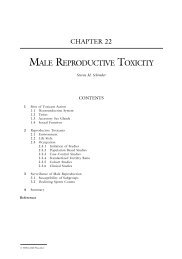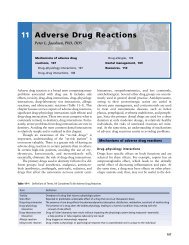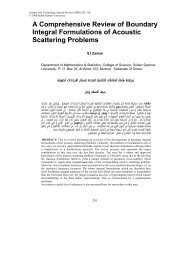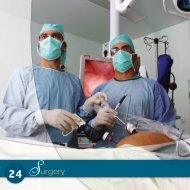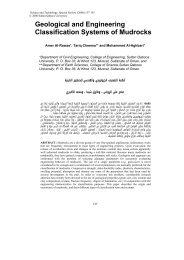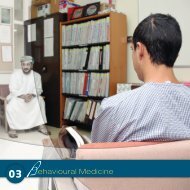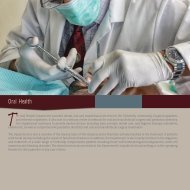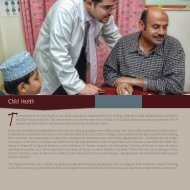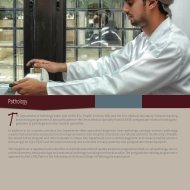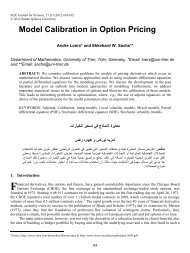81. Neonatal Hypotonia
81. Neonatal Hypotonia
81. Neonatal Hypotonia
- No tags were found...
Create successful ePaper yourself
Turn your PDF publications into a flip-book with our unique Google optimized e-Paper software.
CHAPTER 81NEONATAL HYPOTONIAALAN HILL,MD,PHD<strong>Hypotonia</strong> in the newborn is a common presenting feature of systemic illness or neurologic dysfunction at any level of the centralor peripheral nervous system. In this chapter, the clinical assessment of muscle tone is reviewed as well as the differentialdiagnosis of hypotonia in the newborn, focusing on clinical features and appropriate diagnostic investigations.<strong>Hypotonia</strong> in the newborn, which manifests as a “floppyinfant,” is a common clinical sign that may reflect underlyingsystemic illness or neurologic dysfunction at any levelof the central or peripheral nervous system. This chapterfocuses on aspects of the clinical assessment of muscletone and the differential diagnosis of hypotonia that areunique to newborns.Clinical Assessment ofTone and PostureMuscle tone may be defined as the resistance of muscle tostretch. Evaluation of tone involves both the observation ofresting posture (passive tone) and the assessment of resistanceof the limbs to passive movement or to changes inposture (active tone). The infant’s gestational age, postnatalage, and level of alertness have a major influence ontone and clinical observations should be interpreted in thecontext of these factors.In general, during the development of the nervous systemthere is a caudal-cephalic progression in the maturationof myelination and, consequently, in the developmentof flexor tone, which is reflected in the resting posture ofthe infant and his or her response to passive manipulation.The normal maturation of resting posture and theresponse to passive manipulation at various gestationalages is summarized in Table 81-1.Resting PostureResting posture in a newborn is best observed when theinfant is quiet, in a slightly drowsy state, with the headpositioned in the midline to minimize any influence on theprimary developmental reflexes. Preferential postures aremore difficult to ascertain in premature newborns or whenthe infant is fully alert and exhibits a higher level of activity.The hypotonic term newborn has a characteristic “frogleg”appearance when lying supine, with decreased spontaneousmovements, abduction of the hips, and eitherextension of the arms or flexion at the elbows, with thehands resting beside the head.Interestingly, there is a distinct difference in the restingposture between infants born at term and those born prematurelybut who have reached a postconceptional age of40 weeks, in that infants born prematurely have less armand leg flexion. Thus, a posture characterized by stronglyflexed arms with or without extension of the legs in this lattergroup is suggestive of neurologic dysfunction.Several nonneurologic abnormalities (eg, arthrogryposis,congenital hip dislocation, and flattening of the skullTABLE 81-1.Maturation of Muscle ToneGestational Age (weeks) Resting Posture Response to Passive Manipulation28 Minimal limb flexion Minimal resistance32 Flexion of hips and knees Lower limb flexion36 Flexion of lower limbs (popliteal angle 90°), flexion at elbows Strong lower limb flexion, weak arm flexion40 Flexion and adduction of all limbs Strong flexor response in all limbsCurrent Management in Child Neurology, Third Edition© 2005 Bernard L. Maria, All Rights Reserved <strong>Neonatal</strong> <strong>Hypotonia</strong>BC Decker Inc Pages 528–534
<strong>Neonatal</strong> <strong>Hypotonia</strong> / 529or loss of hair on the occiput) may provide corroborativeevidence of longstanding hypotonia.Passive ManipulationProvided there is no limitation of joint movement (eg,arthrogryposis), flexor tone in the limbs may be evaluatedby observation of the power of recoil after rapid release ofan extended limb. Tone in the trunk and neck is assessedby observation of head and neck control during tractionmaneuvers, horizontal (prone) suspension, and verticalsuspension. The traction response, present by 33 weeks ofgestation, is the most sensitive measure. Thus, at term,when the infant is pulled by the arms from a supine to asitting position, the head should remain aligned with thebody (“absent head lag”) and the infant should respond tothe traction by flexion at the elbows, knees, and ankles. By40 weeks of gestation, when the infant is supported in aprone position with the examiner’s hands under the infant(ie, “horizontal suspension”), extensor tone in the neckmuscles should permit lifting of the head to maintain theneck and trunk in alignment for brief periods. During verticalsuspension when the infant is lifted up by the axillaewith the examiner’s hands around the thorax, the shouldermuscles should be strong enough to permit suspensionof the infant vertically with the head held erect and flexionat the hips, knees, and ankles. In hypotonic infants, thehead typically falls forward and the legs dangle and theinfant has a tendency to “slip through” the hands of theexaminer. Both spasticity (ie, velocity-dependent increasein resistance during passive limb movement) and rigidity(ie, constant increased resistance to passive manipulationthroughout the range of movement) may be tested in newbornsin a fashion similar to that used in older individuals.Examination of resistance of the hips to passive abductionis an important test for spasticity in the lowerextremities (eg, spastic diplegia), a common pattern ofabnormal tone in infants born prematurely.Some investigators have described specific maneuversfor the passive manipulation of limbs in the neonate (eg,approximation of heel to ear, hand to opposite ear “scarfsign,” and measurement of popliteal angle) in an attemptto quantify the maturation of muscle tone.Tendon Reflexes and Plantar ResponseThe formal examination of tendon reflexes in the newbornmay be of limited value because the range of normalityis difficult to define. Thus, there may be markedvariability in the briskness of reflexes from one occasion toanother in the same infant. Reflexes tend to be less activein premature infants. Reflexes in the lower limbs, especiallythe patellar reflexes, typically appear more brisk andare easier to elicit than those in the upper extremities. Theknee jerks may be accompanied by crossed adductorresponses, which, unless pronounced, should not necessarilybe considered abnormal until after 6 to 8 months ofage. Similarly, up to five to ten beats of ankle clonus maybe considered normal, especially in infants who are crying,hungry, or jittery and in whom there are no other signs ofupper motor neuron dysfunction.Classically, the plantar response in the newborn hasbeen considered to be extensor. However, there is considerablevariation in this response depending on the techniqueused because of several competing reflexes that areinvolved. For example, a mild stimulus (eg, dragging thethumbnail along the lateral aspect of the sole of the foot)results in flexion of the toes in more than 90% of infants,whereas a more painful stimulus generally results in anextensor response. Thus, the plantar response should beconsidered to be of limited value for determining the presenceof an upper motor neuron lesion in the newborn.Muscle Power and MovementThe quantity, quality, and symmetry of both spontaneousand elicited movements are of major importance in the evaluationof central nervous system (CNS) function in pretermand term infants. In premature infants, movements of thetrunk and limbs often have a slow, asymmetric, twisting andstretching quality that may resemble athetoid movements.In addition, there may be rapid, jerky, wide-amplitude limbmovements that resemble myoclonus. By 32 weeks of gestation,movements are predominantly flexor, often occurringsymmetrically. By term, infants are particularly active,with smooth, alternating limb movements of medium speedand intensity in response to gentle stimulation.Normal movement patterns in the newborn are characterizedby their overall variability. Consequently, repetitive,stereotypical movements (eg, bicycling of the legs and rowingof the arms) should raise suspicion of neurologicabnormality (eg, seizure). <strong>Hypotonia</strong> is often accompaniedby an overall decrease in spontaneous and elicited movements.Increased frequency of movements may be associatedwith cerebral irritability. Movements that are consistentlyasymmetric may be a sign of focal brain injury orbrachial plexus injury. Jitteriness, which involves markedstimulus-sensitive tremulousness of the limbs that may beinhibited by changing the limb position, may be normal, orit may occur in the context of neurologic dysfunction (eg,hypoxic-ischemic encephalopathy and drug intoxication).Sensory ExaminationCareful sensory examination is important in the contextof hypotonia and should not be limited to eliciting a with-Current Management in Child Neurology, Third Edition© 2005 Bernard L. Maria, All Rights Reserved <strong>Neonatal</strong> <strong>Hypotonia</strong>BC Decker Inc Pages 528–534
530 / The Hospitalized Childdrawal response only. Premature newborns of greater than28 weeks’ gestation are capable of discriminating betweentouch and pain. The rooting reflex, elicited by gentle touchof the perioral region, is established by 32 weeks of gestation.A more accurate approach to the testing of sensoryfunction involves observing the infant’s response to multiple(five) sharp stimuli (eg, pin pricks) to the medialaspect of the extremities, which should elicit a purposefulavoidance maneuver (lateral withdrawal) as well as agrimace or cry after a recognizable brief latentperiod. Furthermore, this response should “habituate” ordecrease with repeated testing. A stereotypical responseand lack of habituation generally indicates considerablecerebral dysfunction. Sensory examination, especially ofthe lower limbs, may be crucial for diagnosing a spinallesion as a cause of hypotonia by determining a definitesensory level.Developmental or Primary<strong>Neonatal</strong> ReflexesThese reflexes represent complex, stereotyped, and patternedresponses of the immature nervous system, theunderlying specific anatomic and physiologic mechanismsof which are largely undefined. Developmental reflexesmay be classified further as postural reflexes (eg, Mororeflex, asymmetric tonic neck reflex), or tactile reflexes (eg,sucking-swallowing and rooting reflexes, grasp reflex, placingand stepping, and trunk incurvation [Galant reflex]).The maturation of the most common developmentalreflexes is outlined in Table 81-2. Clinical abnormalities ofthese reflexes may be classified as (1) lack of an expectedresponse, (2) an asymmetric response, and (3) persistenceof a reflex beyond the expected age of disappearance.Approach to DiagnosisThe major task in the evaluation of a hypotonic newbornis to determine the anatomic level of the underlying pathology(ie, does the hypotonia reflect an abnormality withinthe central or in the peripheral nervous system). Mosthypotonic infants may be categorized on the basis of a carefulhistory and physical examination alone. The major clinicalfeatures that distinguish between cerebral and peripheralhypotonia are summarized in Table 81-3.Clinical Features of Central <strong>Hypotonia</strong>Other evidence of abnormal brain function (eg, abnormallevel of consciousness or seizures) is the strongest clue thathypotonia is of central origin. There may be dysmorphicfeatures or malformations of other organs that suggest anunderlying genetic abnormality. When hypotonia is of centralorigin, the degree of muscle weakness is usually mild,the tendon reflexes are normal or hyperactive, and there isno evidence of muscle fasciculations. Tight fisting of thehands, which do not open spontaneously and in which thethumbs are enclosed by the other fingers or adductedacross the palmar surface (palmar thumbs), is a sign ofcerebral dysfunction. Adduction of the thighs such thatthe legs are crossed when the infant is held in vertical suspension(scissoring) may be evidence of lower limb spasticity.Postural reflexes are generally preserved in infantswith cerebral hypotonia despite a paucity of spontaneousmovements. In fact, in some acute encephalopathies, theMoro reflex may be exaggerated. With extensive hemisphericabnormality but preserved brainstem function, thetonic neck reflex may be “obligatory,” (ie, the posture ismaintained for as long as the head is rotated). Becausehypotonia is a common feature in central disorders in thenewborn, a wide range of investigations may need to beconsidered to establish a precise, underlying diagnosis.Clinical Features ofPeripheral <strong>Hypotonia</strong>In general, disorders of the motor unit are not associatedwith malformations of other organs, except deformities ofbones or joints (arthrogryposis). Muscle weakness is usuallymore marked, and there may be atrophy. Tendonreflexes are usually diminished or absent. Fasciculations,often observed in the tongue, suggest denervation, but areoften very difficult to distinguish from normal randomtongue movements. Postural reflexes are absent or diminishedand limbs that lack voluntary movement also cannotmove reflexively.TABLE 81-2.Maturation of Developmental ReflexesReflex Age at Emergence Age at Disappearance (months)Moro reflex 27 weeks (incomplete) 6Asymmetric tonic neck response 35 weeks 6Sucking and rooting 2nd trimester 4Grasp 27 weeks 2Placing and stepping 34–37 weeks 1–2Trunk incurvation (Galant reflex) 24 weeks 12Current Management in Child Neurology, Third Edition© 2005 Bernard L. Maria, All Rights Reserved <strong>Neonatal</strong> <strong>Hypotonia</strong>BC Decker Inc Pages 528–534
<strong>Neonatal</strong> <strong>Hypotonia</strong> / 531TABLE 81-3.<strong>Hypotonia</strong>Clinical Features of Cerebral and PeripheralCerebralPeripheralClinical Feature <strong>Hypotonia</strong> <strong>Hypotonia</strong>Other abnormal brain function +++ ± (variable)Malformation of other organs + –Tendon reflexes Brisk or normal Decreased or absentPostural reflexes Preserved AbsentFisting of hands + –Fasciculations – ±Facial weakness – VariableLimb weakness ± +++– = feature may be absent; ± = feature variable (may be present or absent); + =feature is present; +++ = major feature (strongly present).A battery of laboratory investigations (eg, serum creatinekinase [CK], cerebrospinal fluid [CSF] analysis, nerveconduction studies and electromyography, neostigmine oredrophonium test, and muscle or sural nerve biopsy) maybe performed to determine the precise level of the pathologicalprocess affecting the motor unit. The greatestadvances in recent years have been made in moleculargenetic testing, which in many instances have obviatedmore invasive investigations.Specific aspects of these investigations relevant to newbornsrequire clarification to avoid pitfalls in the interpretationof results. Thus, elevated levels of serum concentrationsof CK generally imply skeletal or cardiac musclenecrosis, as may occur in rapidly progressive muscular dystrophiesand metabolic myopathies. The blood for CKmeasurement should be obtained before performing theelectromyography or muscle biopsy, as these proceduresmay cause false elevation of CK levels. The CK and isoenzymelevels may be increased 10-fold for up to 1 week followingnormal vaginal delivery (presumably due to muscletrauma). The CK may be even higher in the context ofacidosis (eg, severely asphyxiated newborns). Other biochemicalinvestigations (eg, serum lactate and carnitinelevels) may be required in specific circumstances.A chest radiograph may demonstrate enlarged cardiacsilhouette signifying cardiomyopathy or thin ribs, presumablyrelated to diminished fetal respiratory movements. Thelatter observation is a useful clue to antenatal onset of neuromusculardisease. Markedly increased protein concentrationin CSF may indicate peripheral neuropathy or specificdegenerative conditions (eg, Krabbe’s disease).Nerve conduction studies are consistent and reliableafter 32 weeks of gestation. Nerve conduction velocities,which are slower in normal newborns than in older individuals,may be very slow or unrecordable in the context ofcongenital peripheral neuropathies. The technical performanceand interpretation of the electromyogram (EMG)may be problematic in the newborn. For example, myotonicdischarges, which occur in older individuals with myotonicdystrophy, are rarely elicited in the newborn. Muscle biopsy(either by open surgical technique or needle biopsy) is technicallyfeasible in the newborn. Early biopsy may berequired if there is severe respiratory muscle involvementto provide definitive diagnosis and prognosis to assist managementdecisions. Otherwise, muscle biopsy is often postponedfor several months. In some instances (eg, congenitalmuscular dystrophy), repeated muscle biopsies may beuseful for establishing an accurate diagnosis.Major Disorders Associated withCerebral <strong>Hypotonia</strong><strong>Hypotonia</strong> is a feature of almost every cerebral disorder innewborns and older infants. In many instances, other presentingsymptoms or signs (eg, seizures, intracranial hemorrhage,trauma, and decreased level of consciousness associatedwith moderate or severe hypoxic-ischemicencephalopathy) suggest the most probable underlying diagnosis.However, other disorders may have few clinical featuresother than hypotonia, which may lead to a mistakendiagnosis of disease involving the motor unit. The mostcommon of these latter conditions are listed in Table 81-4and will be discussed briefly as follows.Brain and Spinal Cord Injuryor TraumaModerate or severe acute hypoxic-ischemic encephalopathyis usually suspected on the basis of clinical indicatorsof intrapartum hypoxic-ischemic insult in concert withpostnatal features of encephalopathy (eg, decreased level ofconsciousness or seizures). Intracranial hemorrhage maybe associated with seizures, anemia, and raised intracranialpressure. Cervical spinal cord injury, although uncommon,may be related to traction forces during vaginal delivery,especially in the context of difficult forceps delivery orbreech presentation. In such circumstances, the newborninfant is often flaccid, with absent spontaneous respirations.When infants are conscious, there may be evidenceof preserved cranial nerve function. Tendon reflexes maybe absent initially but become exaggerated later. The bladdermay be distended with overflow incontinence.Genetic and Chromosomal DisordersDown syndrome, the most common chromosomal disorderassociated with neonatal hypotonia, should be easily recognizable.Prader-Willi syndrome is associated with deletionsor translocations of the chromosome 15q11-13 region, andmost commonly, the abnormal chromosome is contributedby the father, although inheritance of both copies of chro-Current Management in Child Neurology, Third Edition© 2005 Bernard L. Maria, All Rights Reserved <strong>Neonatal</strong> <strong>Hypotonia</strong>BC Decker Inc Pages 528–534
532 / The Hospitalized ChildTABLE 81-4.NewbornMajor Causes of Central <strong>Hypotonia</strong> in theI. <strong>Hypotonia</strong> is present at birthBrain and spinal cord injury or trauma: hypoxic-ischemic encephalopathyand intracranial hemorrhageGenetic and chromosomal: Down syndrome and Prader-Willi syndromeCerebral dysgenesis and other structural cerebral abnormalitiesPeroxisomal disorders: cerebrohepatorenal syndrome (Zellwegersyndrome) and neonatal adrenoleukodystrophyOther rare metabolic or genetic conditions: generalized GM1, gangliosidosis,familial dysautonomia, Cohen syndrome, and oculocerebrorenalsyndrome (Lowe syndrome)Benign congenital hypotoniaII. <strong>Hypotonia</strong> usually develops shortly after birthSepsis, including meningitis and encephalitisMetabolic derangements or disordersEndocrine: hypothyroidismDrug intoxicationmosome 15 from the mother (maternal uniparental disomy)may also occur, often in the context of advancedmaternal age. In addition to profound hypotonia andhypogonadism, affected infants have severe feeding difficultiesthat may necessitate prolonged nasogastric tube feeding.Normal respiratory function is helpful for distinguishingthis condition from other disorders of the motor unit. Astime progresses, the muscle tone becomes normal and insatiablehunger, obesity, and mental retardation become evident.Diagnosis is confirmed by chromosome analysis withprophase banding. Specific treatment is not available.Other genetic conditions that present with neonatalhypotonia and feeding difficulties include familial dysautonomia,Cohen syndrome, and oculocerebrorenal syndrome(Lowe syndrome).Peroxisomal DisordersThese neurodegenerative disorders are caused by dysfunctionof peroxisomes, which are subcellular organelles thatassist in the catabolism of very-long-chain fatty acids,pipecolic acid, dicarboxylic acid, and phytanic acid and inthe synthesis of plasmalogens. The most reliable indicatorof peroxisomal disorders is an elevation of very-long-chainfatty acids in blood. Other biochemical abnormalities arehyperpipecolic acidemia and aciduria. Mutations of thePEX1 gene, which are responsible for more than 50% ofcases, may be analyzed in fibroblast cultures and may permitprenatal diagnosis by chorionic villus sampling.Zellweger syndrome (cerebrohepatorenal syndrome) ischaracterized by profound hypotonia, seizures, arthrogryposiswith camptodactyly (limited finger extension) andflexion deformities of knees and ankles, diminished tendonreflexes, and craniofacial dysmorphic features (eg, highforehead, hypertelorism, and unusual fullness of cheeks). Inaddition, there are abnormalities of other organs, includingbiliary cirrhosis, renal cysts, epiphyseal stippling, and retinaldegeneration. <strong>Neonatal</strong> adrenoleukodystrophy is anautosomal recessive peroxisomal disorder with hypotonia,failure to thrive, hepatomegaly, retinitis pigmentosa, andprogressive neurologic deterioration. Adrenal glands arehypoplastic but adrenal failure does not occur. There is nospecific treatment for peroxisomal disorders and deathoften occurs in early infancy.Benign Congenital <strong>Hypotonia</strong>The term “benign congenital hypotonia” has been used todescribe infants who are hypotonic at birth but without aspecific underlying diagnosis and whose tone normalizesduring early childhood. Most probably the term encompassesmany different pathologic entities and affectedinfants have an increased incidence of other features ofcerebral dysfunction (eg, learning difficulties). In these situations,ongoing effort should be directed toward establishmentof a more specific diagnosis.Peripheral Causes of <strong>Hypotonia</strong>Abnormalities at any level of the motor unit may presentwith hypotonia in association with weakness and diminishedtendon reflexes. The major disorders are listed inTable 81-5.Anterior Horn Cell DiseasesThese disorders, specifically spinal muscular atrophy type 1(Werdnig-Hoffmann disease) account for approximatelyTABLE 81-5.Major Peripheral Causes of <strong>Hypotonia</strong>Level of anterior horn cell (lower motor neuron)Spinal muscular atrophy type I (Werdnig-Hoffman disease)Glycogen storage disease type II (Pompe’s disease)Hypoxic-ischemic injury<strong>Neonatal</strong> poliomyelitisLevel of peripheral nerveDemyelinating neuropathies: hereditary or chronic inflammatoryNeuroaxonal dystrophy (rare)MitochondrialLysosomal (Krabbe’s disease)Level of neuromuscular junctionMyasthenia: neonatal transient or congenital myasthenic syndromeToxic-metabolic: hypermagnesemia and aminoglycosidesInfant botulismLevel of the muscleMuscular dystrophy: congenital myotonic and congenital muscular dystrophyMetabolic myopathies: mitochondrial, glycogen disorder, and lipid disordersCongenital myopathies: nemaline (rod body), myotubular (centronuclear),and otherCurrent Management in Child Neurology, Third Edition© 2005 Bernard L. Maria, All Rights Reserved <strong>Neonatal</strong> <strong>Hypotonia</strong>BC Decker Inc Pages 528–534
<strong>Neonatal</strong> <strong>Hypotonia</strong> / 53335% of all newborns with severe hypotonia of neuromuscularorigin. This autosomal recessive disorder is thought toresult from apoptosis of the anterior horn cell. Affectedinfants have generalized weakness, absent deep tendonreflexes, tongue fasciculations, normal sensory function, andnormal CSF examination. The serum CK is usually normalor may be slightly elevated. The diagnosis is confirmed bydeoxyribonucleic acid (DNA) testing in peripheral blood forthe survival motor neuron gene on chromosome 5q (deletionof exons 7 and 8). Muscle biopsy and EMG are often notrequired in the initial evaluation unless the diagnosis cannotbe confirmed by clinical assessment and genetic testing.Electrical studies demonstrate decreased nerve conductionvelocities, low amplitude of the compound muscleaction potential, and spontaneous fibrillations. Musclebiopsy demonstrates severe denervation, with groupedatrophy and hypertrophy of type 1 fibers.Peripheral Nerve DisordersPeripheral neuropathies rarely present during the newbornperiod. Affected infants have generalized hypotoniaand diminished tendon reflexes and may have abnormalsensory examination and elevated CSF protein. The clinicalcourse is variable and may be static or evenreversible. Diagnosis can be confirmed by electrical studiesthat demonstrate slowing of nerve conduction velocities,low compound motor action potentials (CMAPs),and low sensory nerve action potentials (SNAPs). In selectcircumstances, definitive diagnosis may be made by moleculargenetic testing and rarely, sural nerve biopsy.Disorders of theNeuromuscular JunctionAffected infants have hypotonia, cranial nerve dysfunction(ptosis, bulbar dysfunction, and weak cry), areflexia,and normal sensory function.Transient neonatal myasthenia gravis occurs in approximately12% of newborns of mothers with myastheniagravis. It is not related to the severity or duration of thematernal illness or to maternal antibody levels. Affectedinfants usually have hypotonia, ptosis, feeding difficulties,and, possibly, respiratory difficulties, which resolve graduallyover several weeks or months. Diagnosis may be confirmedby a test dose of edrophonium or neostigminemethylsulfate administered intramuscularly or subcutaneously.With the latter medication, a response is expectedwithin 15 to 30 minutes. There is a major advantage of theuse of neostigmine over edrophonium in that the beneficialeffect lasts 1 to 3 hours, which permits repeated and moreprolonged evaluations to establish improvement. Ongoingtreatment with pyridostigmine and supportive care maybe required. Forms of congenital myasthenia gravis thatinvolve abnormal structure of motor end plates are rarelyseen. Response to edrophonium or neostigmine is variableand electrical studies show a decremental response to repetitivenerve stimulation at 20 Hz.Impaired presynaptic release of acetylcholine by toxins(eg, hypermagnesemia following maternal treatment ofeclampsia with magnesium sulfate and treatment withaminoglycoside antibiotics) may result in rapidly progressiveflaccid weakness, bulbar dysfunction, apnea, and autonomicabnormalities (eg, pupillary dilation and urinaryretention). In many instances, the rapid deterioration maybe misdiagnosed as sepsis, which may result in the use ofadditional antibiotic therapy and further aggravation ofthe weakness.Infantile botulism results from presynaptic neuromuscularblockade by a toxin released by the organismClostridium botulinum, which may be present in the gastrointestinaltract of young infants. This organism oftenoriginates from soil, agricultural products, and honey, andthere is wide variation in the incidence of cases, with almostone-half of all cases originating in California, Utah, andPennsylvania, where there are high levels of botulinumspores in soil. The disorder has been described in infantswho are exclusively breastfed. In addition to hypotonia,weakness, and feeding difficulties, affected infants (whowere previously healthy) have impaired pupillary responsesand constipation. Respiratory failure may occur. Diagnosisis confirmed by positive stool culture, or isolation of toxinfrom stool, or by an incremental response on rapid repetitivenerve stimulation (20 to 50 Hz) and abundant smallmotor unit potentials on EMG. Supportive managementwith possible respiratory support is required until the timeof recovery, which may be several months later. There is noproven benefit from antibiotics or antitoxin.Muscular DystrophiesThese genetically determined myopathies are characterizedclinically by progressive weakness. The histology onmuscle biopsy is nonspecific, demonstrating features ofmuscle necrosis, regeneration, and fibrosis. The investigationof these disorders is evolving rapidly with the discoveryof new gene mutations and associated abnormalities inprotein products.Congenital myotonic dystrophy is inherited exclusivelyfrom the mother. Affected newborns generally present witha combination of hypotonia, weakness, respiratory impairment,facial diplegia, feeding difficulties, and arthrogryposis.Occasionally, there may be facial weakness alone,which may remain undetected during the newbornperiod. A history of polyhydramnios or prematurity mayindicate more severe intrauterine onset of disease. There isCurrent Management in Child Neurology, Third Edition© 2005 Bernard L. Maria, All Rights Reserved <strong>Neonatal</strong> <strong>Hypotonia</strong>BC Decker Inc Pages 528–534
534 / The Hospitalized Childa high mortality rate (almost 50%), and survival may bepredicted on the basis of normal suck and swallowingfunction by 12 weeks of age. Significant cerebral dysfunctionis a frequent feature, including neuroimaging abnormalities(eg, dilated cerebral ventricles, cerebral dysgenesis,and periventricular leukomalacia). The serum CK andEMG are often normal. Diagnosis may be confirmed in themother of the affected newborn by an increase in trinucleotiderepeats (CTG) on chromosome 19q13.3.Congenital muscular dystrophies are inherited in an autosomalrecessive fashion and present with weakness, whichmay be static or which may progress. Progressive weaknessand reduced survival often occur in variants with prominentCNS features (eg, cerebral dysgenesis [Fukuyama’ssyndrome], decreased white matter and ocular abnormalities[muscle-eye-brain-disease], and Walker-Warburg syndrome).CNS features include seizures, spasticity, glaucoma,cataracts, or optic nerve abnormalities. Investigations mayreveal normal or moderate elevation of CK, myopathicchanges on EMG, possible neuroimaging abnormalities, anddystrophic changes on muscle biopsy. In cases with CNSinvolvement, immunocytochemical investigations of musclebiopsy tissue may demonstrate deficiency of merosin, aspecific protein in the muscle membrane.Congenital Myopathies withDistinct HistologyMany myopathies are classified according to their distincthistologic appearance observed on muscle biopsy. Usually,they present with hypotonia and relatively mild but staticweakness and, possibly, facial weakness. Exceptions arenemaline myopathy and X-linked myotubular myopathywhich have a severe neonatal variety with respiratory failure.Metabolic MyopathiesRarely, mitochondrial cytopathies (eg, cytochrome-c oxidasedeficiency, carnitine deficiency, carnitine palmityltransferasedeficiency, and glycogen and lipid disorders)may present during the neonatal period. Diagnosisdepends on enzyme assays and muscle biopsy results.Suggested ReadingsDubowitz V. Muscle disorders in childhood. 2nd ed. Philadelphia(PA): W.B. Saunders; 1995.Royden-Jones H, Devivo D, Darras BT. Neuromuscular diseasesof infancy, childhood and adolescence: a clinician’s approach.Philadelphia (PA): Butterworth-Heinemann; 2003.Volpe JJ. Neurology of the newborn. 4th ed. Philadelphia (PA):W.B. Saunders; 2001.Practitioner and Patient ResourcesMuscular Dystrophy Canada (MDC)2345 Young Street, Suite 900Toronto, Ontario M4P 2E5Phone: (416) 488-0030 or 800-567-2873Fax: (416) 488-7523http://www.mdac.caProvides information on neuromuscular diseases and MDC servicesand research, as well as a fund-raising newsletter.Muscular Dystrophy Association(MDA)3300 E. Sunrise DriveTucson, AZ 85718-3208Phone: 800-572-1717Fax: (520) 529-5300E-mail: mda@mdausa.orghttp://www.mdausa.orgProvides information on neuromuscular diseases, MDA services,publications, and the annual telethon.Families of Spinal Muscular AtrophyP.O. Box 196Libertyville, IL 60048-0196Phone: 800-886-1762E-mail: sma@fsma.orghttp://www.fsma.orgProvides information on spinal muscular atrophy, research, andfund-raising resources.Current Management in Child Neurology, Third Edition© 2005 Bernard L. Maria, All Rights Reserved <strong>Neonatal</strong> <strong>Hypotonia</strong>BC Decker Inc Pages 528–534





